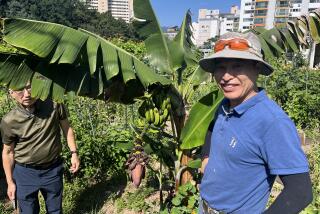Banaba leaf may lower blood sugar
- Share via
Banaba is the Tagalog name for the tree dubbed “pride of India” (more scientifically known as Lagerstroemia speciosa). The purple-flowered tree grows in tropical parts of the Americas, India and the Philippines, where it’s used in traditional medicine to treat diabetes. The tree’s glossy leaves contain high levels of colosolic acid, a plant chemical that reputedly lowers blood sugar levels.
*
Uses: In some Asian medicinal traditions, banaba leaf tea is used to soothe upset stomachs and manage diabetes. Commercial extracts are also sometimes used for weight loss and to boost energy.
Dose: Banaba leaf extract is most often found in multi-ingredient weight-loss supplements such as CortiSlim. Doses vary depending on the product, but are usually from several milligrams to a few dozen per day. Though harder to find, banaba leaf is sold on its own as a liquid extract and in pill form.
Precautions: People with low blood sugar or who are prone to hypoglycemia should avoid banaba-containing supplements. High doses can cause symptoms associated with hypoglycemia, such as headaches and light-headedness.
Research: Banaba leaf extract has been most extensively studied in Japan, where animal and test tube studies suggest it acts similarly to insulin. In obese and diabetic mice, banaba leaf slowed weight gain and helped control blood glucose levels, leading some scientists to believe it could help prevent hyperglycemia and obesity in people with Type 2 diabetes (also known as non-insulin-dependent diabetes). Ongoing research is attempting to determine which components of the leaves are responsible for the insulin-like behavior and whether banaba does for humans what it does for mice.
Dietary supplement makers are not required by the U.S. government to demonstrate that their products are safe or effective. Ask your healthcare provider for advice on selecting a brand.
*
-- Elena Conis




